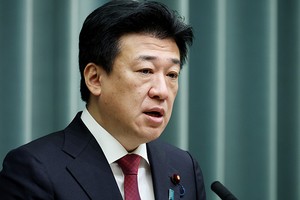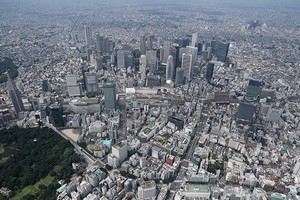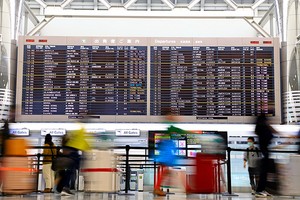THE ASAHI SHIMBUN
August 10, 2024 at 16:00 JST
 The Japan Meteorological Agency holds a news conference to explain what it knows after an earthquake off the Hyuganada Sea on Aug. 8. (Wataru Sekita)
The Japan Meteorological Agency holds a news conference to explain what it knows after an earthquake off the Hyuganada Sea on Aug. 8. (Wataru Sekita)
The subterranean Nankai Trough, which in seismological terms is a ticking time bomb, shows no signs of abnormal subsurface changes following a magnitude-7.1 earthquake in Kyushu on Aug. 8.
The Japan Meteorological Agency said there was nothing to indicate a huge earthquake is in the offing after the one in the Hyuganada Sea off Miyazaki Prefecture in southern Japan.
“Nothing unusual has been observed,” an agency official said.
The offshore Nankai Trough runs along the Pacific coast from the Tokai to the Kyushu regions.
It has been the site of many major earthquakes that spawned devastating tsunami in the past.
In 2017, the central government introduced the Nankai Trough Earthquake Extra Information to assess whether there was a greater possibility of a massive earthquake striking after one with a magnitude of 6.8 or greater had occurred in the assumed epicenter area.
After the Aug. 8 quake, the JMA for the first time issued a Nankai Trough Earthquake Extra Information (Megathrust Earthquake Alert) to warn that a massive earthquake could strike in the coming week.
On Aug. 9, the JMA released data from sites that monitor seismic activity in the Shikoku region, the assumed epicenter of an Nankai Trough earthquake, that measure crustal strain and other parameters.
Despite some changes due to the shaking of the Hyuganada earthquake, no unusual changes were observed afterward, the JMA said.
Based on the observation results, the JMA concluded there was nothing to signal an earthquake was imminent at the plate boundary east of the Hyuganada Sea.
As a temporary measure, the JMA pledged to release information on such seismic observation data until Aug. 15, which will mark one week since the Hyuganada quake.
The Hyuganada Sea where the Aug. 8 earthquake occurred is an extension of the epicenter of magnitude-8-class earthquakes along the Nankai Trough, such as the 1944 Showa Tonankai earthquake and the 1946 Nankai earthquake.
The Aug. 8 earthquake is believed to have been a “plate boundary type” earthquake, in which the gap between the land plate and the subducting Philippine Sea Plate shifted, said Yusuke Yamashita, an assistant professor at the Miyazaki Observatory of Kyoto University’s Disaster Prevention Research Institute.
Like the Great East Japan Earthquake and tsunami that triggered the Fukushima nuclear disaster in 2011, this is a type of earthquake that is of concern in the Nankai Trough.
The plate shifted in the opposite direction from its normal position, causing the seafloor off the coast of Hyuganada Sea to move, which is believed to have triggered a tsunami.
“Both the Hyuganada Sea and the Nankai Trough are connected as faults by the same Philippine Sea Plate, and this time a part of the plate ruptured,” said Takuya Nishimura, a professor of geodesy at Kyoto University’s Disaster Prevention Research Institute.
However, he noted that “the displacement may spread to the surrounding areas, which could result in a huge earthquake.”
Naoshi Hirata, a professor emeritus at the University of Tokyo who chairs the JMA’s Nankai Trough earthquake assessment study group, said at a news conference on Aug. 9, “At this point, we have not obtained any data that indicates a change in plate movement that would trigger a Nankai Trough earthquake.”
(This article was written by Takahiro Takenouchi and Tetsuya Ishikura.)




















A peek through the music industry’s curtain at the producers who harnessed social media to help their idols go global.
A series based on diplomatic documents declassified by Japan’s Foreign Ministry
Here is a collection of first-hand accounts by “hibakusha” atomic bomb survivors.
Cooking experts, chefs and others involved in the field of food introduce their special recipes intertwined with their paths in life.
A series about Japanese-Americans and their memories of World War II